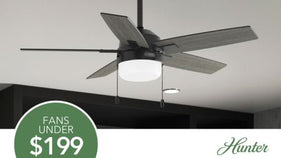- Home
- How to Measure a Ceiling Fan
- How to Measure a Ceiling Fan

How to Measure a Ceiling Fan
A ceiling fan brings both style and function to any space. Whether you're getting a new ceiling fan for the first time or replacing an older one, you'll need to select a fan in the appropriate size for your space. Even if the room already has a fan, it doesn’t necessarily mean it’s the right size for your room. Although there are many options, styles, and models available when choosing a ceiling fan, picking the right size is important for effectively cooling your room, properly circulating fresh air, and reducing stuffiness.
Use the following guide from the experts at Hunter to learn how to measure ceiling fan size.
Time needed:
Less than 30 minutes
Skill Level:
Beginner
Tools needed:
Ladder, Tape Measure,
Calculator
How to Size a Ceiling Fan Table of Contents
- 1. How to measure a room for a ceiling fan
- 2. How to measure a ceiling fan
- 3. How to measure ceiling fan downrod length
- 4. Additional ceiling fan size considerations
This information in these sections will teach you how to know what size ceiling fan to buy so you can feel confident making your purchase.
01.
How to measure a room for a ceiling fan
You may be replacing an old fan, or you may be picking a fixture for a room that didn’t have one before – in either case, you’ll want to measure your space. By taking a few measurements before shopping, you can find the right fit to achieve the best results. Identify which ceiling fan size you'll need for a particular room by first calculating its area. Then, use those measurements to select an appropriate fan size.
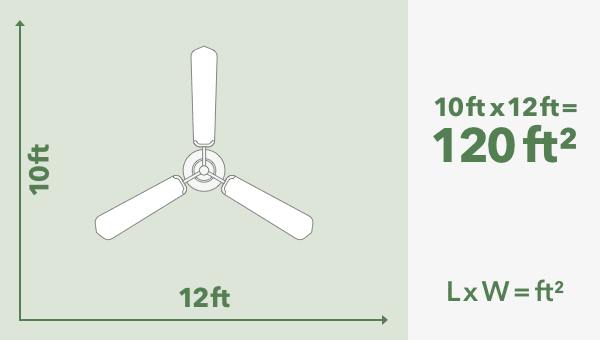
Measure the square footage of the room
When installing a ceiling fan, size matters. For example, ceiling fans ranging from 29 to 36 inches work best for small rooms like home offices and utility rooms that are less than 75 square feet. On the other hand, you need ceiling fans 50 inches or larger to effectively cool most large-sized bedrooms, basements, and living rooms.
Measuring a rectangular room is relatively easy with the following steps:
01. Using a tape measure, determine the length of the room (in feet) by measuring from one wall to the opposing parallel wall.
02. Similarly, determine the width of the room by measuring the distance between the other wall that is perpendicular to the wall you just measured.
03. To calculate the room's area, simply multiply the room's length by its width. For example, a 10-foot by 12-foot room has an area of 120 square feet.
If your room is L-shaped, factor its square footage by dividing the space into two non-overlapping rectangles. After measuring the square footage of both sections, add those numbers together and you'll have the total area.
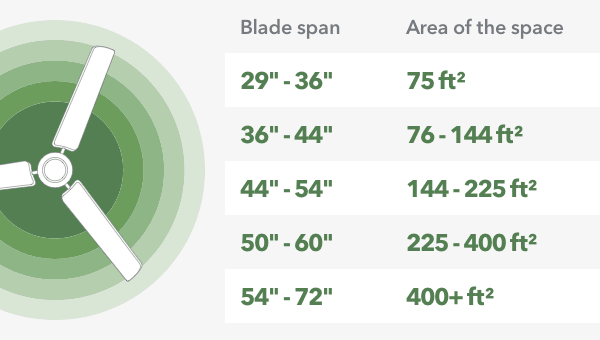
How to use your measurements to select a fan size
Once you know the room’s square footage, use your measurements to select the right fan size.
Refer to the following chart to coordinate the square footage of your space with the appropriate blade span to provide optimal air circulation. If you don’t have a fan yet, simply look for the square footage of your room in the chart and find the corresponding blade span.
In larger spaces, consider installing multiple fans to increase air circulation and comfort level.
02.
How to measure a ceiling fan
When you’re buying a new ceiling fan, the fan size will be listed on the fan’s box or on the product’s webpage. Easy enough. But, to determine if your existing ceiling is the right size for your space, you’ll need to learn how to measure the diameter of a fan. A ceiling fan that’s too small doesn’t circulate air effectively; alternatively, a fan that’s too large overpowers the room (and no one wants papers blowing everywhere).
Knowing how to measure the ceiling fan’s diameter will let you compare the length of the blade span to the square footage of your room using the table from section one. First, use the following information to learn how to measure ceiling fan length.
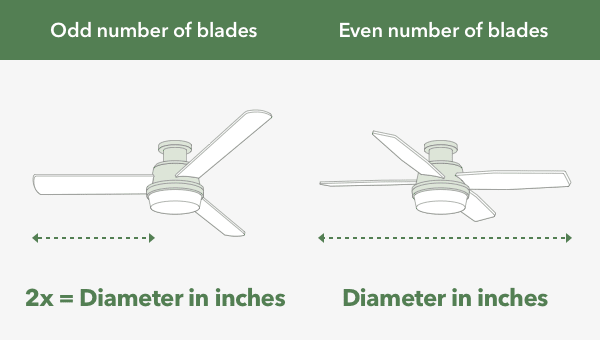
Measuring a fan diameter
When you're shopping for ceiling fans, you'll notice that their sizes are measured in inches. These measurements are referred to as the blade span or the sweep of the fan, which is the same as the diameter. The way to measure a ceiling fan diameter varies based on blade count.
Follow these steps on how to measure the blade span of a ceiling fan:
01. Before measuring, turn the power to the fan off and wait for the blades to stop spinning.
02. Using a step ladder if needed, hold your tape measure at the tip of the blade.
03. If your fan has an even number of blades, measure the distance between the tip of the blade to the tip of the opposing blade to determine the diameter.
04. If your fan has an odd number of blades, measure the distance between the tip of the blade and the center of the fan to determine its radius. Then, multiply that number by two to determine the diameter.
To ensure that air will circulate efficiently, your ceiling fan blades should have approximately 30 inches of clearance from the walls.
Once you have your measurements, remember to refer to the chart from section 1 and make sure the diameter aligns with your room size before purchasing a replacement. If it’s not the right size, use the chart to get the recommended fan size for the square footage of your space.
03.
How to measure ceiling fan downrod length
A ceiling fan downrod is the piece of hardware that connects the mounting bracket to the fan body (also referred to as the motor housing) to increase stability, reduce the risk of wobbling, and ensure the proper hanging height for efficient performance. You’ll need to consider how low the fan should hang to ensure an optimal distance between the ceiling and the fan blades as well as provide enough clearance space between the blades and the tops of people’s heads. For adequate air circulation, your ceiling fan blades should have at least eight inches of clearance from the ceiling, and for maximum safety, your ceiling fan should hang at least seven feet above the floor.
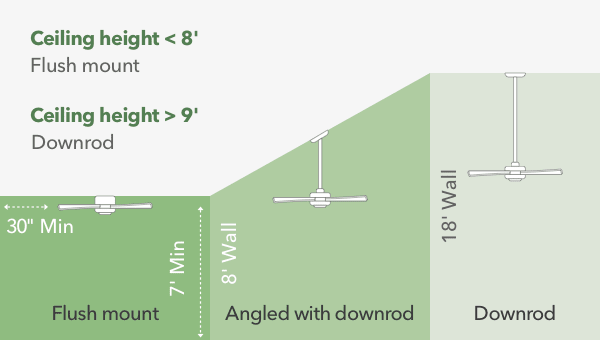
Measuring ceiling height
Use a tape measure and a step ladder to calculate the distance from the floor to the ceiling. This measurement will indicate the type of fan you want to install:
01. For ceiling heights less than eight feet, you'll need a low-profile ceiling fan.
02. If your room has a ceiling height of nine feet or more, install a ceiling fan with a downrod.
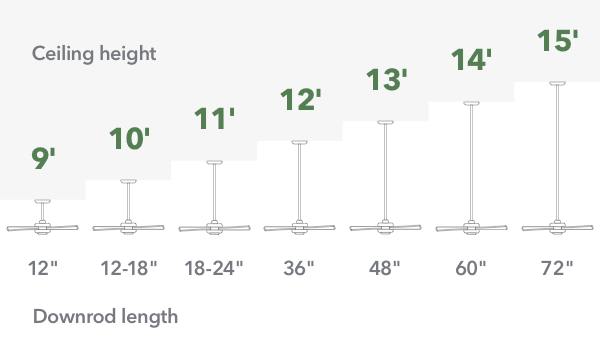
Calculating downrod length
If your ceiling is tall enough to require a downrod, follow these steps to calculate the right ceiling fan downrod length:
01. Use a tape measure (or refer to the product dimensions) to find the height of the ceiling fan you want to install. This will include the motor housing and lighting fixture (if applicable) without the downrod. This information may also be in the user manual or on the box.
Most fan housings have a height between 8 to 12 inches.
02. Subtract the fan height from your ceiling height.
03. Then, subtract that number from your desired hanging height to find the appropriate downrod length.
Remember: Your fan blades should have a minimum of seven feet of clearance from the floor and a minimum 30 inch of clearance from the nearest wall or door.
So, if you have 12-foot ceilings and you want to install a 12-inch ceiling fan, that means you have 11 feet between the floor and the fan. If your preferred hanging height is eight feet, you’ll need a three-foot downrod.
04.
Additional ceiling fan size considerations
When installing a new ceiling fan or replacing an old one, it's important to remember that every situation will be different. Take the following considerations into account when determining the ceiling fan size you'll need:
Light kits
When measuring the height of ceiling fans with lights, keep in mind that the light kit will add extra inches. Include those in your calculation.
Support
Ceiling fans vary in weight. Make sure the area you mount the fan is strong enough to support the fixture and has the appropriate electrical junction box.
Obstacles
When calculating your downrod length, take potential obstacles like cabinets, furniture, and doors into account. The tips of the fan blades need a 30-inch clearance to properly fit your space.
Ceiling shape
If your ceiling is angled or sloped less than 32 degrees, the bracket that comes with your Hunter fan will work. If its angle is greater than 32 degrees, you'll need to purchase an angled ceiling mount adapter.
When you purchase ceiling fans that fit your space and ceiling height, you can add a functional and eye-catching design statement to a variety of different rooms. The above guide from Hunter Fan Company should help you learn how to measure a ceiling fan and calculate the right downrod length to choose the right fan size for your space.
